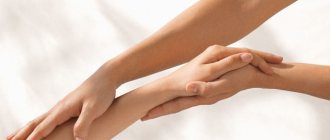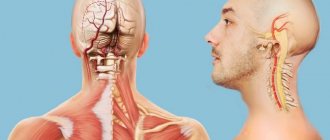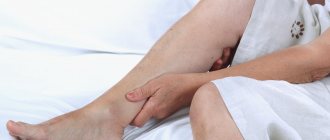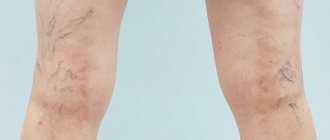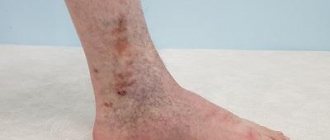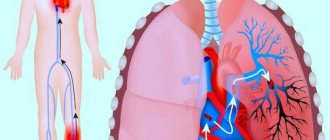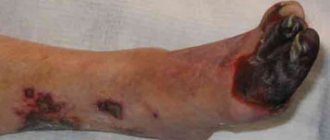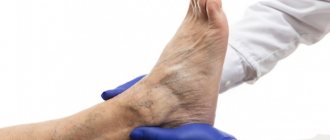Lymphedema, lymphostasis or “elephantiasis” is a chronic disease, which is based on a violation of the outflow of fluid (lymph) from tissues, which is clinically manifested by edema.
The lesion is predominantly unilateral; less often, both arms or both legs may be involved in the process. Some patients may have swelling of the genitals, chest, and head. Often, lymphostasis is a consequence of surgical removal of lymph nodes in the armpit/groin area or their damage after radiation/chemotherapy. That is, normal lymph drainage is difficult. The disease can also be caused by the growth of a tumor that directly presses on the lymphatic vessels.
Unfortunately, lymphedema is very difficult to treat. But with competent and conscientious treatment, it is quite possible to control it. Therefore, do not delay visiting a phlebologist.
Stages of lymphedema
Stage 0 – lymphatic vessels are damaged, but there is no swelling yet due to the body’s compensatory mechanisms
Stage 1 – transient mild swelling that occurs gradually throughout the day. When pressed with a finger, a hole is formed
Stage 2 – the skin begins to thicken (fibrosis), it is not always possible to make a dimple in the skin, the swelling is significant and dense, does not go away after rest
Stage 3 – severe swelling and skin changes
(Clinical classification of lymphedema, International Society of Lymphology)
Why you should contact ANTIREFLUX:
- We see both a lymphologist and a phlebologist. Often, both specialists consult with each other when choosing the optimal treatment method (thus, each case of lymphedema in ANTIREFLUX is considered by a mini-consultation , from an individual angle - taking into account the existing root causes and concomitant pathologies).
- Our Center has created all the conditions for receiving qualified care and comfort for each patient . We have the latest high-tech diagnostic and treatment equipment - and the level of high professionalism of our specialists is not questioned not only in Russia, but also far beyond its borders.
- Among our doctors are doctors and candidates of medical sciences , authors of a significant number of textbooks and monographs, members of the Association of Phlebologists of Russia, who regularly take part in domestic and Western conferences.
- The doctors who will treat you are real experts in the phlebological industry: at the ANTIREFLUX Center they regularly take advanced training courses for doctors specializing in endovenous laser and scleroblitating techniques for the treatment of venous pathology.
- Well, and, of course, no one has yet canceled the notorious “human factor ”: in the cozy atmosphere of our clinic, patients feel much more comfortable than in the dull walls of the average government hospital - and the kind-hearted attitude of the doctors leaves no doubt about their sincere desire to help.
Signs and symptoms of lymphedema
- Swelling of the extremities, including the arms, hands, legs, feet. This may be the entire limb or just part of it. It can be one-sided or two-sided.
- Swelling proximally to the chest, shoulder, pelvis, groin, genitals, face/intraoral tissues.
- Pain and feeling of fullness, discomfort in the joints.
- Limbs may feel heavy and painful.
- Decreased mobility and range of motion of the affected limb.
- Change in sensitivity.
- Skin changes such as redness and fever.
- Hyperkeratosis (thickening of the skin) and lymphangiectasia (dilated superficial lymphatic vessels)
Treatment of lymphedema
Complex physical decongestant therapy (CPDT) is a method that is the gold standard in the treatment of lymphostasis, which often achieves tangible results and significantly reduces swelling, which leads to an improvement in the patient’s quality of life.
This technique includes:
- manual lymphatic drainage massage;
- compression therapy (banding with low-tensile bandages in the 1st phase, wearing flat compression hosiery in the 2nd phase);
- skin care;
- therapeutic exercises.
Forecast
The chances of recovery depend on the underlying disease and treatment. Here it is also necessary to understand the difference between primary and secondary lymphedema.
In the primary form of the disease, a 100% cure is excluded. An innate tendency to edema, regardless of its cause, leads to the pathology occurring again and again. However, consistent preventative measures can keep swelling well controlled. With secondary lymphatic disease, recovery is possible. Cure of the underlying disease allows you to exclude lymphedema of the extremities in the future
Although therapy is aimed at treating swelling, not all patients respond equally to the measures taken. It is often necessary to use multiple treatment methods simultaneously.
In general, the prognosis for healing of edema is good. But it is also worth mentioning the frequency of relapses, especially with primary lymphatic disease.
Surgical treatment of lymphedema
There are many methods of surgical treatment of lymphedema, which have a number of indications and contraindications.
Microsurgical techniques are also used:
- Transfer of vascularized lymph nodes from another part of the body to the affected area (VLNT).
- Lymphatic-venous anastomoses (LVA): VLNT and LVA are microsurgical procedures that can improve physiological drainage of lymphatic fluid and eliminate the need for constant wearing of compression garments in some patients. These procedures provide better results when there is less damage to the patient's lymphatic system.
- Suction-assisted protein lipectomy (SAPL). This technique is more effective in the later stages of lymphedema and allows you to remove excess fatty tissue that cannot be removed by conservative therapy for lymphedema or VLNT or LVA operations.
Diagnosis of lymphostasis
If you suspect lymphostasis and have its symptomatic manifestations, you should urgently contact a phlebologist, lymphologist or vascular surgeon.
Diagnosis of lymphostasis does not involve much difficulty. The specialist will ask you about your current complaints and perform a physical examination. With severe forms of edema, a preliminary diagnosis is made immediately and is almost always confirmed. With minor, spontaneous reversible edema, the pathology should be carefully differentiated.
Diagnostic procedures for detecting lymphostasis include the following procedures:
- Ultrasound of blood vessels of the lower extremities;
- Ultrasound of the abdominal organs, retroperitoneum and pelvis;
- Computed tomography or MSCT (multispiral computed tomography) of the chest organs;
- Radiography;
- Laboratory blood tests (biochemistry, lipid profile).
The specificity of therapy depends entirely on the specific causes that caused the disease. They are clarified in the process of differential diagnosis, together with the form, localization and stage of development of the pathology. Treatment is combined – causal and symptomatic. Initially, our specialists will focus their efforts on alleviating your condition, especially if it is quite severe. In parallel with this, causal therapy will be carried out, which will help eliminate the catalysts for relapses and complications of the disease.
Sometimes lymphedema and lymphostasis require surgical intervention to reconstruct regional lymph nodes and vessels.
Skin care for lymphedema
Skin lesions and infections are common complications of lymphedema. Skin care is one element of comprehensive decongestive therapy and is part of both the deedema phase (Phase I) and the maintenance phase (Phase II).
Due to the daily wearing of compression bandages and knitwear, the skin can become dry and prone to minor damage and scratches. This, in turn, increases the risk of introducing bacteria that can cause infections. Deep folds of skin that can form due to swelling also increase the risk of infection.
Any infection can further damage your lymphatic system and make symptoms worse. The goal of skin care for lymphedema is to keep the skin intact and reduce the risk of infection as much as possible.
The skin of patients with lymphedema is usually very sensitive, dry and itchy due to metabolic disorders and changes in macro- and microcirculation. This makes it susceptible to inflammation and infection. By impairing the healing process, skin damage can lead to severe inflammation, infection (eg, erysipelas), or even ulcers that worsen the condition.
Skin infections should be treated immediately. Do not self-medicate; skin infections should be treated by a doctor.
- To keep the skin supple and strong, patients should choose mild (pH = 7) or slightly acidic (pH = 5) cleansers for daily use, as well as gentle, fragrance-free moisturizers.
- Care should be taken to dry the skin completely after a bath or shower, especially in deep skin folds, to minimize the risk of infection. Use soft towels for this, dry the skin gently, avoiding strong friction.
- After cleansing the skin, it should be moisturized with mild moisturizers.
- Skin care products should be applied with light massaging movements. Do not wear compression garments unless the products are completely absorbed.
- Avoid scented products, which often cause skin irritation.
- Immediately disinfect and treat any cuts, scrapes, or insect bites. For this, use non-alcoholic antiseptic solutions - chlorhexidine, miramistin. Afterwards, sprinkle the damage with Baneocin.
- Avoid unnecessary trauma to the affected limb, such as taking blood samples or injections, and use a thimble when sewing and gloves when cleaning the house or gardening.
- Pay attention to nail care. Perform a hardware manicure or push back the cuticles with a wooden stick.
- Avoid direct sunlight. Use sunscreens with a high sun protection factor (SPF 50+). When in the sun, wear clothing that protects your skin from sunburn.
- Do not use razors; it is better to replace them with an electric razor.
- Keep in mind that your individual skin condition will determine which treatment and product is best for you. Products that simultaneously moisturize the skin and maintain its protective layer are preferred.
- Do not measure blood pressure on the affected arm.
- Avoid pronounced temperature fluctuations (baths, saunas, ice holes, very hot showers, contrast showers, compresses). Avoid classic massage on the side of the operation (arm, chest, upper back).
- Don't abuse alcohol. It causes dilation of blood vessels, which is accompanied by the accumulation of fluid in the tissues.
- Limit your salt intake.
- Drink enough fluids per day - it does not affect the degree of swelling.
- Maintain a normal body weight.
Complications
Repeated episodes or lack of timely treatment for lymphostasis can lead to the following complications:
- Lymphangitis
. An infection of the lymphatic vessels, mainly caused by streptococcus bacteria. If left untreated, it can spread to the skin, causing sepsis. - Psychological disorders
. Changes in appearance, in turn, can have a psychological impact. Patients with lymphedema are at higher risk of developing depression. - Erysipelas
. Due to injury, bacteria penetrate the skin and an inflammatory process develops. Symptoms include chills, high fever, nausea and vomiting. The area of injury may experience superficial redness, excessive heat, and burning pain. - Lymphatic cysts
. They are dilated lymphatic pathways and appear as small blisters on the surface of the skin. - Benign skin tumors
. Strong tension and pressure of tissues on the skin leads to the appearance of papillomas. Reducing pressure due to compression stockings or lymphatic drainage usually causes the papillomas to disappear.
As a rule, complications go away on their own after eliminating the cause of lymphostasis. In serious cases, symptomatic therapy is required.
How does exercise help treat lymphedema?
A good place to start is with range of motion exercises and stretching. Contracting and relaxing muscles helps move lymph and also strengthens the lymphatic system. Avoid static loads on the affected limb.
Every 20-30 minutes it is recommended to change body position. When sitting, move your limb more often: bend/extend the elbow/knee joint, rotate your hands/feet clockwise and counterclockwise, clench/unclench your fingers (at least 15-20 times).
It is important to add aerobic activities that improve fitness and reduce body weight: Nordic walking, swimming, cycling, walking, dancing, tai chi and gentle yoga (except upper body weight bearing positions, at least in the beginning) ). Once the condition improves and the lymphedema stabilizes, the exercise plan is expanded. Recommended physical activity is 150–300 minutes of aerobic activity per week. That is, 6 times a week for 30 minutes of cyclic exercise.
Even if you have exercised before, start gradually and slowly increase your physical activity. It is important to be patient.
- Avoid overexerting yourself as this may increase swelling.
- Always warm up and cool down.
- Stop training if you feel tired, uncomfortable or have pain in your limbs!
- Recovery is important - rest and remember to elevate the limb.
- Wear compression clothing during the day and during sports. The only exception is training in water, as this can damage the material of the compression garments.
- In addition to exercise, it is important to remember to eat a balanced diet - this is another key element of a healthy lifestyle.
At the National Medical Research Center of Oncology named after. N.N. Petrov carries out complex physical decongestant treatment of lymphedema. First, the patient should consult a rehabilitation specialist who will assess the patient’s condition and determine the presence or absence of contraindications to complex physical decongestant therapy. Depending on the spread of the disease, the patient will be offered a set of measures.
If lymphedema is in an early stage, it is possible to select compression hosiery, prescribe a set of exercise therapy exercises, and learn self-massage.
In more serious cases, complex physical decongestant therapy is prescribed, which includes alternating manual lymphatic drainage massage followed by bandaging and physical therapy to reduce swelling. Then specialists select flat-knit compression stockings and teach the patient proper skin care. A set of exercises is selected for independent performance.
For prevention, it is advisable to perform these procedures two to three times a year or as needed when symptoms of the disease return.
Prevention
It is unlikely that lymphedema can be prevented. There is no vaccination against this. However, the risk of developing the disease can be minimized by eliminating risk factors:
- if you are overweight, you should definitely seek medical help to eliminate obesity;
- if you are prone to edema, it is especially important to follow a healthy diet;
- playing sports activates muscle activity, increasing lymph flow;
- stress contributes to the narrowing of the lymphatic and circulatory pathways, so stressful situations should be excluded.
Timely treatment of concomitant diseases is of great importance in the prevention of lymphedema. It is also recommended to eliminate bad habits and lead a healthy lifestyle.
